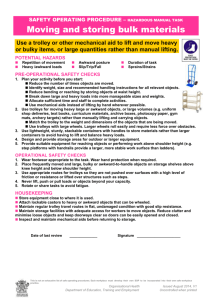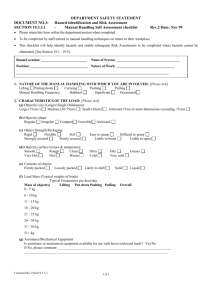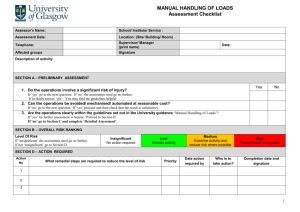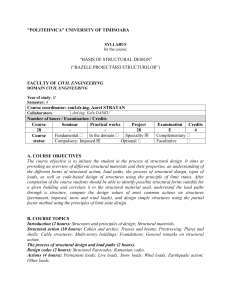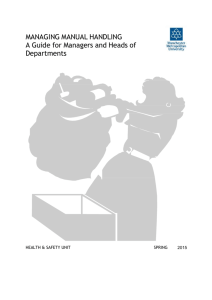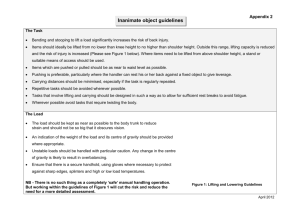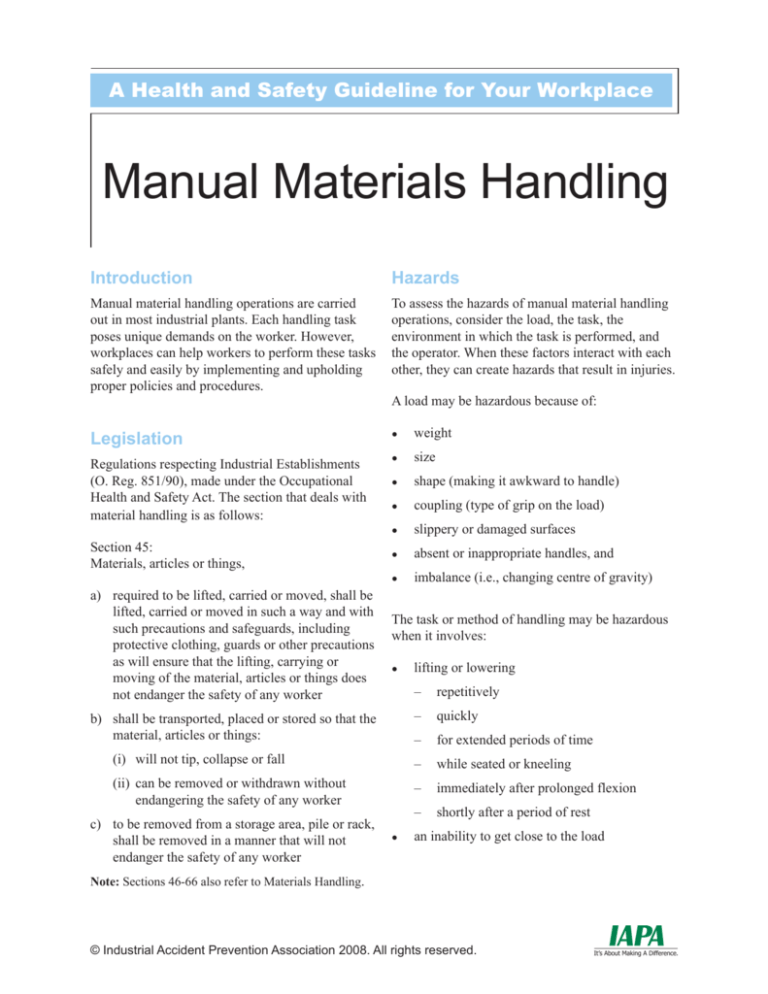
A Health and Safety Guideline for Your Workplace
Manual Materials Handling
Introduction
Hazards
Manual material handling operations are carried
out in most industrial plants. Each handling task
poses unique demands on the worker. However,
workplaces can help workers to perform these tasks
safely and easily by implementing and upholding
proper policies and procedures.
To assess the hazards of manual material handling
operations, consider the load, the task, the
environment in which the task is performed, and
the operator. When these factors interact with each
other, they can create hazards that result in injuries.
Legislation
●●
weight
●●
size
●●
shape (making it awkward to handle)
●●
coupling (type of grip on the load)
●●
slippery or damaged surfaces
●●
absent or inappropriate handles, and
●●
imbalance (i.e., changing centre of gravity)
Regulations respecting Industrial Establishments
(O. Reg. 851/90), made under the Occupational
Health and Safety Act. The section that deals with
material handling is as follows:
Section 45:
Materials, articles or things,
a) required to be lifted, carried or moved, shall be
lifted, carried or moved in such a way and with
such precautions and safeguards, including
protective clothing, guards or other precautions
as will ensure that the lifting, carrying or
moving of the material, articles or things does
not endanger the safety of any worker
A load may be hazardous because of:
The task or method of handling may be hazardous
when it involves:
●●
lifting or lowering
–– repetitively
–– quickly
b) shall be transported, placed or stored so that the
material, articles or things:
–– for extended periods of time
(i) will not tip, collapse or fall
–– while seated or kneeling
(ii) can be removed or withdrawn without
endangering the safety of any worker
–– immediately after prolonged flexion
c) to be removed from a storage area, pile or rack,
shall be removed in a manner that will not
endanger the safety of any worker
–– shortly after a period of rest
●●
an inability to get close to the load
Note: Sections 46-66 also refer to Materials Handling.
© Industrial Accident Prevention Association 2008. All rights reserved.
●●
moving the load over large distances
Control Measures
●●
accuracy and precision required because of
The best control measure is to eliminate the need
for workers to perform manual handling tasks.
Since this is not always possible, design manual
handling tasks so that they are within the workers’
capabilities. Considerations include the load itself,
the design of the workstation and work practices.
Providing mechanical handling devices or aids can
often eliminate the task itself or ease the demands
on the worker.
–– fragile loads, or
–– specific unloading locations
●●
materials positioned too low or too high
●●
hazardous movements or postures (e.g.,
twisting, extended bending and reaching)
●●
multiple handling requirements (e.g., lifting,
carrying, unloading)
Environmental factors include:
Task Design
●●
temperature (beyond a 19–26°C range)
The Load
●●
relative humidity (beyond a 35–50% range)
Reduce the weight of the load by decreasing the:
●●
lighting
●●
size of the object (specify size to suppliers)
●●
noise
●●
weight of the container (e.g., plastic is
●●
time constraints (e.g., machine–paced work or
deadline pressures)
●●
lighter than steel)
physical conditions such as
●●
capacity of containers
●●
●●
load in the container
–– obstacles
–– floor surfaces (e.g., slippery, uneven or
damaged)
Operator characteristics that affect the handling of
loads include:
●●
general health
●●
physical factors
–– height
–– reach
–– flexibility
–– strength
–– weight
–– aerobic capacity
●●
pre-existing musculoskeletal problems
●●
psychological factors
Conversely, consider increasing the weight of the
load so that it may only be handled mechanically.
This can be done by the use of:
●●
palletized loads, and
●●
larger bins or containers
Decrease the load on the worker by:
●●
limiting the number of objects he/she is
required to handle during the day
●●
designating heavier loads as team lifts (i.e., two
or more persons)
●●
changing the size and shape of the load so that
the worker can get closer to the load’s centre of
gravity
–– motivation
–– stress
Manual Materials Handling
© Industrial Accident Prevention Association 2008. All rights reserved.
2
Work Station Design
Reduce the distance over which the load has to be
moved by relocating production and storage areas.
Design work stations so that workers:
●●
can store and handle all material between
knuckle and shoulder height; waist height is
most desirable
●●
can begin and end handling material at the
same height
●●
can face the load and handle materials as close
to the body as possible
●●
do not have to handle loads using awkward
postures or an extended reach, and
●●
do not handle loads in confined spaces that
prevent them from using good body mechanics
Facilitate access to material by:
●●
providing workbenches and other work stations
with toe cut-outs, so that workers can get closer
to the load
●●
supplying bins and totes with removable sides
●●
removing obstructions, such as unnecessary
railings on bins
Work Practices
Lifting and Lowering
Eliminate the need to lift or lower manually by
providing and ensuring proper use of:
●●
lift trucks, cranes, hoists, scissor lifts, drum
and barrel dumpers, stackers, work dispensers,
elevating conveyors, articulating arms and
other mechanical devices
●●
gravity dumps and chutes
●●
power lift tail gates on trucks, and hand trucks
to ensure easy transfer of material from the
truck to ground level
●●
portable ramps or conveyors to lift and lower
loads on to work stations
Pushing and Pulling
Eliminate pushing or pulling by ensuring the use
of:
●●
powered conveyors, powered trucks, slides,
chutes, monorails, air tables and similar
mechanical aids
Make loads easier to push or pull by ensuring the
use of:
●●
carts, hand trucks and dollies with large
diameter casters and good bearings, and
●●
grips or handles on loads or mechanical aids,
placed to provide optimal push force and
prevent awkward postures
Instruct employees to:
●●
push rather than pull
●●
avoid overloading – limit the load pushed or
pulled at one time
●●
ensure the load does not block vision
●●
never push one load and pull another at the
same time
Manual Materials Handling
© Industrial Accident Prevention Association 2008. All rights reserved.
3
Carrying and Holding
Storage
Reduce carrying and holding forces by:
Provide proper storage facilities such as:
●●
●●
evaluating the work flow – determine if heavy
loads can be moved mechanically over any
distance
converting the operation into a pushing or
pulling task
●●
providing carts, slings or trolleys
●●
providing portable containers in which to place
awkward loads
●●
providing grips or handles on loads
●●
limiting the distance over which the load is
moved
●●
storage boxes and containers that can be
●●
lifted mechanically rather than requiring
manual handling
●●
avoid deep shelving that make retrieving or
placing a load difficult
●●
racks or shelf trucks to store material, thus
eliminating the need for lifting the containers
●●
storage bins and containers with fold down
sides for easier access to loads
When storing loads, employees should:
Environmental Factors
●●
store loads in easy to access locations
Maintain an optimum environment by ensuring
that:
●●
store loads between knuckle and shoulder
height
●●
the temperature of the work area is at an
acceptable level
Personal Factors
●●
in a hot environment
Clothing
–– workers take frequent breaks away from
the heat
Wear appropriate clothing and safe, comfortable
shoes:
–– workers drink frequently from liquids
provided near the work site
●●
clothes that are comfortable around the hips,
knees and shoulders, and that do not have
exposed buttons or loose flaps, and
●●
non-slip shoes with broad based low heels.
Safety footwear is essential when handling
heavy loads on a regular basis
●●
in a cold environment,
–– workers wear good insulating clothing
–– loads are easy to handle when gloves and
heavy clothing are worn
●●
humidity is at an acceptable level
●●
lifting instructions can be heard in a noisy
environment
●●
lighting levels are adequate for the work place
●●
the layout of the work area provides better
access to the load
●●
the aisles are clear of obstacles
●●
signs are posted where there are gradients in
the slope of the floor; whenever possible, limit
such slopes to 10 degrees
Manual Materials Handling
© Industrial Accident Prevention Association 2008. All rights reserved.
4
Fitness
Maintenance
Encourage workers to remain in good physical
condition by participating in regular exercise
programs. To stay healthy, Health Canada’s
Physical Activity Guide recommends 60 minutes
of light effort, or 30 minutes of vigorous effort,
every day.
Establish a preventive maintenance program, with
input from equipment manufacturers, to ensure that
the following is completed on a regular basis:
Incorporating exercise is easier than you think. For
example:
●●
use the stairs, not the elevator
●●
walk instead of driving
●●
stretch or exercise between TV shows
The following tips can also enhance fitness:
●●
use good body mechanics when sitting,
standing, lifting, etc. For example, when
lifting:
–– maintain a curve in the lower back
–– stabilize the back by lightly contracting the
stomach muscles
●●
take regular task breaks to avoid or reduce
muscle fatigue
●●
get adequate sleep on a good mattress
●●
eat sensibly; follow the Canada Food Guide
General Precautions
Instruct employees to take the following
precautions when handling loads:
●●
test the weight of the load to ensure it can be
lifted securely; if not, make adjustments
●●
cleaning of wheels and bearings on hand carts
and other mechanical aids
●●
lubricating as necessary
●●
replacing worn and defective wheels and
casters
●●
checking that all mechanical aids work
efficiently
Training
Traditional training has focussed on proper lifting
methods and safe work procedures. More recently,
workplaces have introduced fitness and back
education approaches. In combination with job and
workplace design changes, these approaches are
effective in preventing accidents and injuries.
On the job demonstrations and practice sessions are
the best methods of training. Cover basic manual
materials handling procedures, and the proper
use of mechanical aids and techniques. Regularly
reinforce the proper techniques to ensure their
continued use.
The objectives of material handling training are to
teach the worker:
1. how to identify hazardous loads or handling
tasks
2. the proper selection and use of mechanical
handling aids
●●
grip the load securely
3. safe postures and manual lifting techniques to
minimize strain
●●
protect hands against pinch points
4. safe lifting techniques
●●
practice good team lifting
●●
get help with awkward loads
●●
always use the mechanical devices and aids
provided
●●
don’t rush or cut corners
Manual Materials Handling
© Industrial Accident Prevention Association 2008. All rights reserved.
5
© INDUSTRIAL ACCIDENT PREVENTION
ASSOCIATION, 2001, 2005, 2006, 2008.
All rights reserved. As part of IAPA’s mission to inform and
educate, IAPA permits users to reproduce this material for their
own internal training and educational purposes only. For any
other purpose, including use in conjunction with fee for service
or other commercial activities, no part of this material may be
used, reproduced, stored in a retrieval system, or transmitted in
any form or by any means, electronic, mechanical, photocopy,
recorded, or otherwise, without the express prior written
permission of the Industrial Accident Prevention Association.
The information contained in this material is provided
voluntarily as a public service. No warranty, guarantee
or representation is made by IAPA as to the correctness,
suitability, fitness, or sufficiency of any information contained
in this material. Use of this material means that the user agrees
that IAPA and its employees will not have and are released
from any liability whatsoever, however caused or arising, in
connection therewith. Users also acknowledge that it cannot
be assumed that all acceptable safety measures are contained
in this material or that additional measures may not be required
in the conditions or circumstances that are applicable to the
user or his/her organization, and that the user will personally
make his/her own assessment of the information contained in
this material.
While IAPA does not undertake to provide a revision service
or guarantee accuracy, we shall be pleased to respond to your
individual requests for information.
Revised: May 2008
Industrial Accident Prevention Association
Toll-free: 1-800-406-IAPA (4272)
Website: www.iapa.ca
Manual Materials Handling

